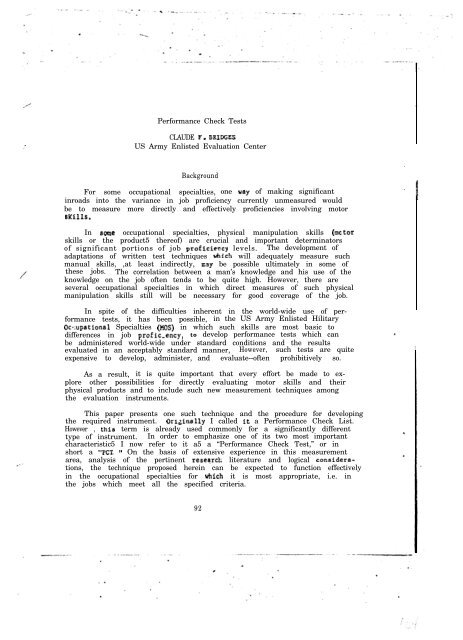Technical Report - International Military Testing Association
Technical Report - International Military Testing Association
Technical Report - International Military Testing Association
Create successful ePaper yourself
Turn your PDF publications into a flip-book with our unique Google optimized e-Paper software.
Performance Check Tests<br />
CLAUDE P. BRIDGES<br />
US Army Enlisted Evaluation Center<br />
Background<br />
For some occupational specialties, one way of making significant<br />
inroads into the variance in job proficiency currently unmeasured would<br />
be to measure more directly and effectively proficiencies involving motor<br />
sKills.<br />
In some occupational specialties, physical manipulation skills (nctor<br />
skills or the product5 thereof) are crucial and important determinators<br />
of significant portions of job proficieacy levels. The development of<br />
adaptations of written test techniques uhic!r will adequately measure such<br />
manual skills, ,at least indirectly, msy be possible ultimately in some of<br />
these jobs. The correlation between a man’s knowledge and his use of the<br />
knowledge on the job often tends to be quite high. However, there are<br />
several occupational specialties in which direct measures of such physical<br />
manipulation skills still will be necessary for good coverage of the job.<br />
In spite of the difficulties inherent in the world-wide use of performance<br />
tests, it has been possible, in the US Army Enlisted Hilitary<br />
Oc-:upational Specialties (HOS) in which such skills are most basic to<br />
differences in job profit-ency, to develop performance tests which can<br />
be administered world-wide under standard conditions and the results<br />
evaluated in an acceptably standard manner, However, such tests are quite<br />
expensive to develop, administer, and evaluate--often prohibitively so.<br />
As a result, it is quite important that every effort be made to explore<br />
other possibilities for directly evaluating motor skills and their<br />
physical products and to include such new measurement techniques among<br />
the evaluation instruments.<br />
This paper presents one such technique and the procedure for developing<br />
the required instrument. 0rl;inally I called it a Performance Check List.<br />
However , thie term is already used commonly for a significantly different<br />
type of instrument. In order to emphasize one of its two most important<br />
characteristic5 I now refer to it a5 a “Performance Check Test,” or in<br />
short a “PCT . ” On the basis of extensive experience in this measurement<br />
area, analysis of the pertinent reseqrch literature and logical considerations,<br />
the technique proposed herein can be expected to function effectively<br />
in the occupational specialties for vhich it is most appropriate, i.e. in<br />
the jobs which meet all the specified criteria.<br />
92<br />
�<br />
.<br />
.<br />
I









